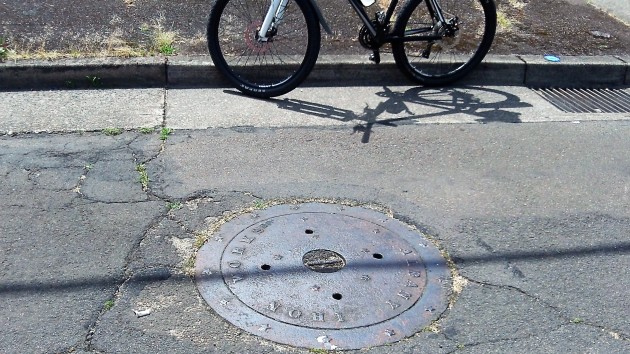
There’s local history under your feet, or your wheels in this case. And if you’re on a bike it’s easy to see by just looking down.
Living in Albany for many years, I had heard of the Albany Iron Works from time to time. The other day I’m riding down Railroad Street in the old industrial part of town when this manhole cover, glinting in the afternoon sun, caught my eye. It’s bigger than the ones in common use now, and from the size and the amount of wear I’d guess it’s probably close to a century old.
This one is in the block of Railroad between Second and Third. All together, I counted five of these apparent antiques in that street. It got me wondering about the company that made them.
It’s surprising what you can find rooting around online. There is, for instance, the secretary of state’s report to the 1913 legislature listing all the state’s expenses of the previous two years. Among them, on May 22, 1911,the state penitentiary paid Albany Iron Works for five separate orders of “castings” — iron bars perhaps? — on invoices ranging from $493 to $1,149 each.
Elsewhere the online scavenger learns that the factory was established in 1866 and that it continued in business until closing in 1950. It was based in the block between Water and First avenues east of Montgomery Street. For a time, the two-story brick building at 131 Montgomery N.E., the oldest surviving former industrial building in town, served as the Iron Works pattern shop. When the company started, steamboats coming up the Willamette delivered iron ore from mines at Oswego. (I’d never heard of iron mines in Oswego, but that’s what it says in a 1976 historical inventory.)
None of the works buildings remain. Today their memory is kept alive by the nomenclature of the Iron Works townhouses and office building as well as the Foundry Lofts apartments on the former industrial site.
Albany Iron Works made fittings for buildings all over Oregon. Few remain because many were removed and smelted for the arms industries during the two world wars. Not, however, those manhole covers. They’re an indestructible reminder of Albany as a thriving industrial center a century ago. And you can see them if, at the right time, you look down. (hh)

And here’s another look, complete with a carelessly discarded butt.


Fascinating. Thank you for this piece of local history.
Thirteen stars on the outer ring and seven inside. Might the iron works have had some southern leanings?
Very likely. The Civil War ended in 1865 and the date forged in the manhole covers is 1866. Seven states seceded when Lincoln was elected, and when Fort Sumter was fired upon in 1861 four “northern southern states” joined them. So the combination of 13 and 7 seems significant.
I also seem to recall that our area had a goodly number of “southern leanings” (sympathizers) during the civil war. Wasn’t Fort Hoskins also a small part of the process to contain the rebellion?
The first National Confederate flag (Stars and Bars) had seven stars in a circular pattern. Later that was expanded to thirteen although two of the States claimed did not secede. The Confederate Battle Flag (which was in recent news) had thirteen stars in a St. Andrews cross pattern.
Very nice Hasso.
I love these local history vignettes. Thanks, Hasso.
The Bob Potts photo collection has a few photos of the Albany Iron Works. A couple can be seen in the “Remembering When” series put out by the Albany Regional Museum.
Thanks for pointing these out. With the old poultry processing plant on First and Washington recently being demolished, very little remains of what was once a thriving industrial district along Water Avenue.
Hasso, I think that there was another “Albany Iron Works” that came later and was a company that made structural beams, I think one of their last jobs was the frame of the Oregon Freeze Dry office building. I sold them a bunch of welding electrode while it was going together.
I’m sure you’re right, Rich. In fact, a Google search will turn up a seemingly current Albany Iron Works Inc. But I’m guessing they don’t make manhole covers.(hh)
Albany Iron works was also where CL Best, who went along to found Caterpillar tractors used to work. There’s a book called “Making Tracks” by Ed and Sue Clasessen about it. Lots of history there.